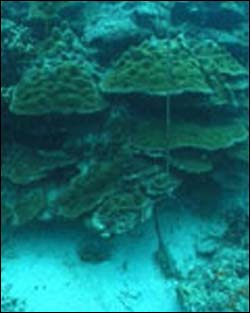Hidden sponges determine coral reef’s nutrient cycle

Sander Scheffers investigated sponges in coral reefs off the island of Curaçao.
Marine organisms hidden in caves, such as sponges, play an extremely important role in the nutrient cycle of coral reefs. Indeed they probably play the most important role of all, says Dutch biologist Sander Scheffers. And that is valuable information for nature conservationists who want to preserve the coral reefs.
In order to protect coral reefs it is important to understand how both the reefs and their environment function. Researchers often concentrate on subjects such as physical damage to reefs, the bleaching of coral and coral diseases. Sander Scheffers investigated a lesser-studied subject: the nutrient cycle on the coral reef and the role that organisms living in cavities, such as sponges, play in this.
Underwater camera
To determine the nature and size of this role, Scheffers first of all examined the precise appearance and quantity of these virtually inaccessible caves and their living communities. He did that on the Caribbean island of Curaçao using a special underwater camera. The films shot revealed that sponges were the most important inhabitants, followed by animals such as tube worms, tunicates and bivalves. Together they fill more than 60 percent of the cavities. Further the cavities were found to have a surface area eight times greater than that of the coral reef, as seen from above by divers.
Filterers
And according to Scheffers a larger living surface also means a larger filtering surface. Sponges filter the water. They take up planktonic particles such as bacteria and excrete inorganic nutrients. In turn, these nutrients can facilitate the growth of marine plants and other organisms.
Sponges filter at a phenomenal rate: if the seawater were to remain stationary, the sponges would have completely pumped it away within five minutes, i.e. they would have removed all of the small plankton from it. This is of course not the case, as there is a continuous supply of fresh water into the sea. According to Scheffers, these hidden organisms play a key role in the marine nutrient cycle due to their incredible capacity to convert enormous quantities of organic plankton into inorganic material.
The results from Scheffers’ research have been made available to the personnel from the Marine under water park of Curaçao and have been presented to the local government.
Sander Scheffers’ research was funded by NWO-WOTRO.
Media Contact
More Information:
http://www.nwo.nlAll latest news from the category: Ecology, The Environment and Conservation
This complex theme deals primarily with interactions between organisms and the environmental factors that impact them, but to a greater extent between individual inanimate environmental factors.
innovations-report offers informative reports and articles on topics such as climate protection, landscape conservation, ecological systems, wildlife and nature parks and ecosystem efficiency and balance.
Newest articles

Superradiant atoms could push the boundaries of how precisely time can be measured
Superradiant atoms can help us measure time more precisely than ever. In a new study, researchers from the University of Copenhagen present a new method for measuring the time interval,…

Ion thermoelectric conversion devices for near room temperature
The electrode sheet of the thermoelectric device consists of ionic hydrogel, which is sandwiched between the electrodes to form, and the Prussian blue on the electrode undergoes a redox reaction…

Zap Energy achieves 37-million-degree temperatures in a compact device
New publication reports record electron temperatures for a small-scale, sheared-flow-stabilized Z-pinch fusion device. In the nine decades since humans first produced fusion reactions, only a few fusion technologies have demonstrated…





















